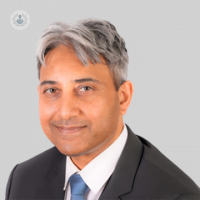How is treatment for head and neck cancer improving?
Written in association with:In his recent online article, highly renowned ENT specialist Mr Taran Tatla provides an insight into the field of head and neck cancer treatment, the incredible progress we’ve made over the last 40 years, and what patients can expect in the future.

Head and neck cancer is one of the major forms of cancer, accounting for 7-8% of all cancers in the UK. In other countries, this figure is even higher. In Asia, for example, around 30-40% of cancers occur in the head and neck, possibly because of the widespread practice of chewing tobacco, smoking cheap cigarettes and a poor diet. Worldwide, head and neck cancer causes 300,000 deaths every year.
Despite its prevalence, head and neck cancer seems to get far less attention than breast, colon, lung or prostate cancer. Perhaps this is because we are really talking about 30 different types of cancer, all lumped under one banner. Head and neck cancer can include cancer of the mouth, tongue, nose, ear, larynx, and the thyroid gland – and each one is unique in their symptoms and treatment. It isn’t something you can explain easily at a fundraising event.
Treatment for head and neck cancer: past and present
The key challenge with treating head and neck cancer is that it is so visible. It can affect our breathing, swallowing, speech, senses, and our appearance. This means that when we look at improving treatment for people with head and neck cancer, we’re not just aiming for better cure rates – our challenge is to restore function and quality of life.
Just 30-40 years ago, treatment for head and neck cancer was primitive. If you survived the treatment, that was a success. Unfortunately many people were left with disfiguring scars, voice and swallowing problems, deafness, or loss of sight.
Since then, we’ve come a long way in restoring function and quality of life to patients. We are now able to reconstruct the voice mechanism to restore speech within three weeks after surgical removal of the voice box. Immunotherapy has become a key part of treatment for some types of cancer and advances in radiotherapy mean we can target tumours more effectively with reduced side effects.
We’ve also come far in terms of diagnosis and awareness. For example, we have seen a decrease in smoking-related mouth cancer among the UK population due to successful public health campaigning. More recently, we were successful in persuading the UK government to introduce the HPV vaccine to teenage boys, as well as girls – a key step in the fight against tonsil cancer.
The future of head and neck cancer
Despite these advancements, too many patients still suffer from speech, eating, or breathing difficulties following treatment, so we have improvements to make in this regard. Treatment must also adapt to the changing “face” of head and neck cancer – with more patients who are younger and presenting with tonsil cancer in association with the human papilloma virus (HPV).
It is clear that momentum is building and I am confident we will continue to make great strides in our treatment of patients and ultimately minimise the impact of head and neck cancer on quality of life.
If symptoms and diagnosis are made early, there is an 80-90% chance of cure, but it is important that patients are treated in recognised head and neck cancer centres where cure rates are significantly better than national statistics. It is important to remember that these statistics are historical and they do not necessarily reflect your prospects today. Leading cancer centres are constantly striving to improve survival rates and outcomes and to reduce the adverse side effects of treatment.



